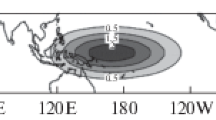Abstract—
By using a nonstationary numerical thermohydrodynamic model of atmospheric tides genesis and evolution in the Earth’s atmosphere, it is shown that the Moon can initiate the growing unstable nonstationary disturbances of meteorological parameters in the troposphere. It is shown that the genesis of disturbances is initiated by lunar atmospheric tides, atmospheric compressibility is the main factor of genesis, and a vertical background wind shear (baroclinic instability) is a complementary factor. The spatial and time scales of unstable disturbances initiated by atmospheric lunar tides vary within the following ranges: the characteristic build-up time from 50 to 200 h and the quasi-period of unstable disturbances from 7 to 30 days. Based on an analysis of the results of numerical experiments, it is concluded that the global unstable nonstationary disturbances initiated by the Moon may generate weather cycles in the mid- and high-latitude troposphere of both Earth’s hemispheres lasting 1 to 4 weeks. The initial phase of genesis of these cycles is closely related to the continuously varying position of the gravitational tide-generating source on the celestial sphere, i.e., the lunar phase. The conclusion presents arguments for a similar effect of planets in the Solar System on the Earth’s weather through gravitational tides and instability of the Earth’s atmosphere.






Similar content being viewed by others
REFERENCES
Bjerknes, V., Application of line integral theorems to the hydrodynamics of terrestrial and cosmic vortices, Astrophys. Norv., 1937, vol. 2, no. 6, pp. 262–340.
Dikii, L.A., Teoriya kolebanii zemnoi atmosfery (Theory of Fluctuations of the Earth’s Atmosphere), Leningrad: Gidrometeoizdat, 1969.
Dymnikov, V.P. and Filatov, A.N., Ustoichivost’ krupnomasshtabnykh atmosfernykh protsessov (Stability of Large-Scale Atmospheric Processes), Leningrad: Gidrometeoizdat, 1990.
Eyring, V., Cox, P.M., and Williamson, M.S., Taking climate model evaluation to the next level, Nat. Clim. Change, 2019, vol. 9, no. 102, pp. 102–110.
Fleming, E.L., Chandra, S., Barnett, J.J., and Corney, M., Zonal mean temperature, pressure, zonal wind, and geopotential height as functions of latitude, Adv. Space Res., 1990, vol. 10, no. 12, pp. 11–59.
Gavrilov, A.A., Physical and mathematical modeling of the origination and propagation of lunar atmospheric tides and estimation of their effect on the formation of global weather on the Earth, in Vtoraya mezhdunarodnaya nauchnaya shkola molodykh uchenykh: Tez. dokl. (Second International Scientific School of Young Researchers: Abstracts of Presentations), Moscow: Print pro, 2016, pp. 59–63.
Gavrilov, A.A., Model estimates of the effect of lunar atmospheric tides on terrestrial weather, in Materialy 54-kh Nauchnykh chtenii pamyati K.E. Tsiolkovskogo (Proceedings of the 54th Scientific Readings in Commemoration of K.E. Tsiolkovskii), Kaluga, 2019, vol. 2, pp. 218–219.
Gavrilov, A.A. and Kaidalov, O.V., Investigation of the interaction between variations in atmospheric thermal tides and anomalous ozone concentration, Adv. Space Res., 1996, vol. 17, no. 11, pp. 157–160.
Gill, A., Atmosphere–Ocean Dynamics, London: Academic, 1982; Moscow: Mir, 1986.
Kapitsa, A.P. and Gavrilov, A.A., Assessment and forecast of the teleconnection between the Antarctic ozone and water vapor and the circulation and temperature of the lower thermosphere over the regions of Russia, Dokl. Earth Sci., 2010, vol. 434, no. 1, pp. 1200–1204.
Landau, L.D. and Lifshits, E.M., Mekhanika sploshnykh sred. Gidrodinamika i teoriya uprugosti (Continuum Mechanics. Fluid Mechanics and Theory of Elasticity), Moscow: Gostekhteoretizdat, 1953.
Lorenz, E., Deterministic nonperiodic flows, J. Atmos. Sci., 1963, vol. 20, pp. 130–141.
Lorenz, N.E., Predictability: Does the flap of a butterfly’s wings in Brazil set off a tornado in Texas?, Address at the 139th Annual Meeting of the American Association for the Advancement of Science, Boston, Mass., December 29, 1972.
Marchuk, G.I., Chislennye metody v prognoze pogody (Numerical Methods in Weather Forecast), Leningrad: Gidrometeoizdat, 1967.
Ruelle, D. and Takens, F., On the nature of turbulence, Commun. Math. Phys., 1971, vol. 20, no. 3, pp. 167–192.
Schneider, T., The general circulation of the atmosphere, Ann. Rev. Earth Planet. Sci., 2006, pp. 655–688.
Shakina, N.P., Gidrodinamicheskaya neustoichivost’ v atmosfere (Hydrodynamic Instability in the Atmosphere), Leningrad: Gidrometeoizdat, 1987.
Sidorenkov, N.S., Celestial mechanical causes of weather and climate change, Izv., Atmos. Ocean. Phys., 2016, vol. 52, no. 7, pp. 667–682.
Sidorenkov, N.S. and Petrov, V.N., On vivid manifestations of perigean spring tides in the atmosphere, Izv., Atmos. Ocean. Phys., 2020, vol. 56, no. 7, pp. 713–720. https://doi.org/10.1134/S0001433820070075
Stouffer, R.J., Eyring, V., Meehl, G.A., Bony, S., Senior, C., Stevens, B., and Taylor, K.E., CMIP5 scientific gaps and recommendations for CMIP6, Bull. Am. Meteorol. Soc., 2017, vol. 98, pp. 95–105.
Author information
Authors and Affiliations
Corresponding author
Ethics declarations
The author declares no conflict of interest.
Additional information
Translated by L. Mukhortova
Rights and permissions
About this article
Cite this article
Gavrilov, A.A. The Moon is the Source of Unstable Nonstationary Disturbances in the Earth’s Atmosphere. Izv. Atmos. Ocean. Phys. 57, 703–711 (2021). https://doi.org/10.1134/S0001433821070069
Received:
Revised:
Accepted:
Published:
Issue Date:
DOI: https://doi.org/10.1134/S0001433821070069



